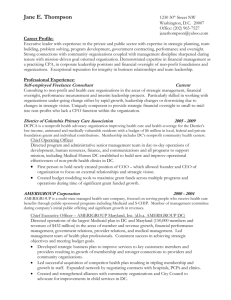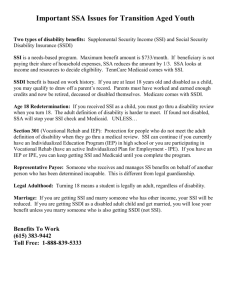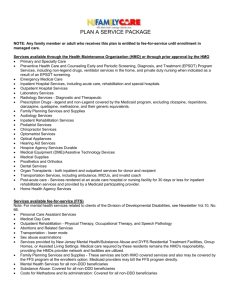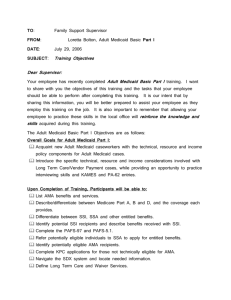2005 innovations awards program
advertisement
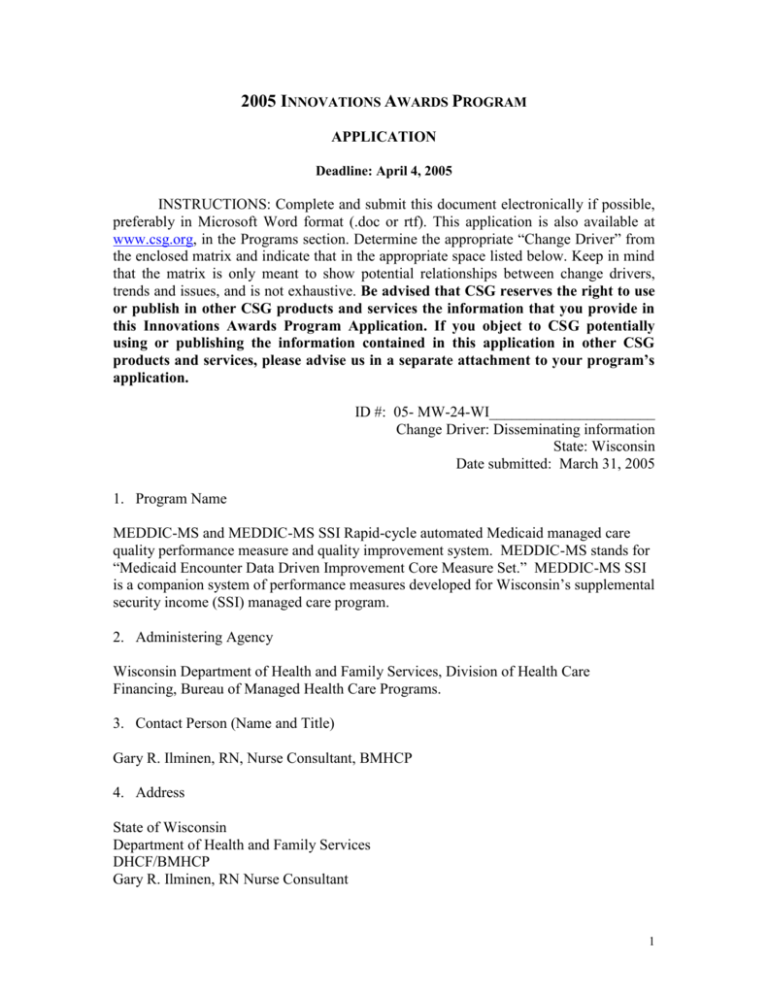
2005 INNOVATIONS AWARDS PROGRAM APPLICATION Deadline: April 4, 2005 INSTRUCTIONS: Complete and submit this document electronically if possible, preferably in Microsoft Word format (.doc or rtf). This application is also available at www.csg.org, in the Programs section. Determine the appropriate “Change Driver” from the enclosed matrix and indicate that in the appropriate space listed below. Keep in mind that the matrix is only meant to show potential relationships between change drivers, trends and issues, and is not exhaustive. Be advised that CSG reserves the right to use or publish in other CSG products and services the information that you provide in this Innovations Awards Program Application. If you object to CSG potentially using or publishing the information contained in this application in other CSG products and services, please advise us in a separate attachment to your program’s application. ID #: 05- MW-24-WI______________________ Change Driver: Disseminating information State: Wisconsin Date submitted: March 31, 2005 1. Program Name MEDDIC-MS and MEDDIC-MS SSI Rapid-cycle automated Medicaid managed care quality performance measure and quality improvement system. MEDDIC-MS stands for “Medicaid Encounter Data Driven Improvement Core Measure Set.” MEDDIC-MS SSI is a companion system of performance measures developed for Wisconsin’s supplemental security income (SSI) managed care program. 2. Administering Agency Wisconsin Department of Health and Family Services, Division of Health Care Financing, Bureau of Managed Health Care Programs. 3. Contact Person (Name and Title) Gary R. Ilminen, RN, Nurse Consultant, BMHCP 4. Address State of Wisconsin Department of Health and Family Services DHCF/BMHCP Gary R. Ilminen, RN Nurse Consultant 1 1 W. Wilson St., PO Box 309 Madison, WI 53701-0309 5. Telephone Number (608) 261-7839 Office 6. FAX Number (608) 261-7792 Fax 7. E-mail Address ilmingr@dhfs.state.wi.us 8. Web site Address http://www.dhfs.state.wi.us/medicaid7/providers/index.htm 9. Please provide a two-sentence description of the program. Cost-effective automated healthcare performance measure systems are essential to future quality improvement efforts in the nation's publicly-funded managed healthcare programs, particularly in financially pressured state Medicaid programs. Wisconsin has successfully deployed such a system on a state-wide basis. 10. How long has this program been operational (month and year)? Note: the program must be between 9 months and 5 years old on May 1, 2005 to be considered. The systems were deployed in routine operation in October 2002, however, the ability to use electronically available HMO encounter data allowed retrospective reporting for some performance measures for CY 2000. 11. Why was the program created? What problem[s] or issue[s] was it designed to address? Indicate how the program applies to the “change driver” that you listed above. State Medicaid programs are trying to comply with the requirements of the new Medicaid Managed Care Final Rule. Specifically, 42 CFR §438.240(c) requires that states monitor managed care organization (MCO) performance using standardized performance measures specified by the state and that HMOs submit data necessary for the performance measures to operate. Public reporting—dissemination of information—on complex health care system performance issues is now mandatory. Doing it clearly, accurately, and cost-effectively is made possible by this innovation. Prior to the development of MEDDIC-MS and MEDDIC-MS SSI, the state’s own managed care performance measures and all other available existing managed care 2 performance measure systems were slow, administratively complex, costly and cumbersome. They relied heavily on costly and intrusive medical record review for data acquisition. The MEDDIC-MS and MEDDIC-MS SSI automated rapid-cycle performance measures are the first to be implemented in a large publicly-funded healthcare delivery system to leverage advanced data technology, merged data streams and targeted measure denominator design to produce valid, accurate performance data without medical record review, duplicative (and often inaccurate) measure calculation by each HMO and with the flexibility and speed necessary to meet changing program needs. Automated performance measurement is essential in modern healthcare. The Institute of Medicine (IOM) underscores its importance in the 2002 book, "Leadership by Example: Coordinating Government Roles in Improving Health Care Quality." According to the IOM, healthcare performance monitoring systems should have three essential qualities: Measures "derived from computerized data and public reporting of comparative quality information." "Providers should not be burdened with reporting the same patient-specific performance data more than once to the same government agency." "Finally, effective performance measurement demands real-time access to sufficient clinical detail and accurate data. By the time retrospective performance measures reach decision-makers, it is too late for them to be useful. The current health information environment is far too fragmented, technologically primitive, and overly dependent on paper medical records." The IOM noted that these qualities are of particular importance to publicly funded healthcare delivery systems such as state Medicaid programs. In large measure, MEDDIC-MS and MEDDIC-MS SSI meet the IOM’s criteria. The MEDDIC-MS and MEDDIC-MS SSI systems of quality performance measures may be thought of as "automated" because they have several characteristics, including: Performance measurement data is generated routinely from normal operations, such as monthly HMO encounter data. Electronic data is used. Costly, slow and intrusive paper medical record review for data extraction has been eliminated. Unlike most existing systems, performance measures can be calculated at any time allowing performance measure cycle times to vary from calendar-year cycle times, if needed. HMO encounter data can be merged with other State-controlled electronic data streams to improve data accuracy and completeness. 3 HMOs do not calculate or report any performance measures, reducing duplicative costs while eliminating inaccuracy that may be caused by variations in interpretations of measure specifications or data systems. Instead, an independent third party calculates all the performance rates, assuring consistency and preventing any “gaming” of the results. MEDDIC-MS operates more closely to "real-time" because calculation of performance measures is not hampered by the need to wait for medical record review data. 12. Describe the specific activities and operations of the program in chronological order. The performance measure results obtained by the operation of the MEDDIC-MS and MEDDIC-MS SSI systems are used for: Managed care program evaluation for state program managers for the Medicaid (AFDC/TANF/HS), BadgerCare (SCHIP) and SSI managed care programs. Decision support Strategic assessment of the quality improvement program Federal and state regulatory and compliance reporting Compliance with federal program quality strategy requirements Public reporting of program results Informing enrollees to support choice among top-performing HMOs for new enrollees or enrollees desiring to change HMOs Data for production of the state’s Medicaid HMO Report Card. Provides a mechanism for driving performance improvement through a systematic performance improvement goal-setting process. 13. Why is the program a new and creative approach or method? MEDDIC-MS and MEDDIC-MS SSI are the first and, at present the only state-specified, state-developed Medicaid, SCHIP and SSI managed care performance measures that have been evaluated and approved by the Agency for Healthcare Research and Quality (AHRQ) for inclusion on the National Quality Measures Clearinghouse (NQMC®). To view the measure summaries on the NQMC, go to: http://www.qualitymeasures.ahrq.gov/resources/measureindex.aspx and scroll down to "State of Wisconsin." To our knowledge, they are the first measure sets to meet the IOM criteria for automated healthcare performance measurement and the first to eliminate both the use of paper medical record review and all HMO performance measure calculation and reporting for Medicaid managed care. These operating features eliminate some of the most costly, intrusive and administratively complex characteristics of other common Medicaid managed care performance measure systems. 4 14. What were the program’s start-up costs? (Provide details about specific purchases for this program, staffing needs and other financial expenditures, as well as existing materials, technology and staff already in place.) No additional staff or resources were required for development and implementation of the program; all costs fell into the existing program budget. 15. What are the program’s annual operational costs? Routine operational costs are folded into the existing budget, specific costing was not necessary. 16. How is the program funded? General purpose revenue (GPR). 17. Did this program require the passage of legislation, executive order or regulations? If YES, please indicate the citation number. No. 18. What equipment, technology and software are used to operate and administer this program? Existing MMIS data streams and hardware were used, but innovative technical specifications for the measures allowed it to be used in a new, much more effective way. 19. To the best of your knowledge, did this program originate in your state? If YES, please indicate the innovator’s name, present address, telephone number and e-mail address. Yes. Other states are working to develop or identify alternatives to existing managed care performance measure sets, including systems that use encounter data, however, our recent review of state Medicaid managed care performance measures and reporting did not reveal any comprehensive systems of encounter data-driven measures in current use. MEDDIC-MS and MEDDIC-MS SSI are the first and, at present the only state-specified Medicaid, SCHIP and SSI managed care performance measures that have been evaluated and approved by the Agency for Healthcare Research and Quality (AHRQ) for inclusion on the National Quality Measures Clearinghouse (NQMC®). To view the measure summaries on the NQMC, go to: http://www.qualitymeasures.ahrq.gov/resources/measureindex.aspx and scroll down to "State of Wisconsin." 5 Gary R. Ilminen, RN Nurse Consultant, BMHCP was the project lead for development and deployment of the MEDDIC-MS and MEDDIC-MS SSI systems. Input and technical support came from many internal and external stakeholders, including participating HMO quality improvement and clinical staff. State of Wisconsin Department of Health and Family Services DHCF/BMHCP Gary R. Ilminen, RN Nurse Consultant 1 W. Wilson St., PO Box 309 Madison, WI 53701-0309 20. Are you aware of similar programs in other states? If YES, which ones and how does this program differ? No. (See item 19 above.) 21. Has the program been fully implemented? If NO, what actions remain to be taken? Yes. Public reporting of measure results is done on the state’s website at: http://www.dhfs.state.wi.us/medicaid7/providers/index.htm . 22. Briefly evaluate (pro and con) the program’s effectiveness in addressing the defined problem[s] or issue[s]. Provide tangible examples. Evidence of program effectiveness--pros Reliance on intrusive medical record review for performance measurement has been all but eliminated—it is still used for annual HMO encounter data validity audits conducted by the state. Duplicative performance measure calculation and reporting by each HMO has been eliminated. Duplicative auditing and validation by the State of HMO reporting has been eliminated. Annual HMO encounter data validity audits are conducted by the state, streamlining the data validation process. Comprehensive, timely public reporting of clinical quality results in the State's Medicaid/BadgerCare HMO program has been achieved. The system is capable of operating more closely to "real time." Wisconsin's MEDDIC-MS and MEDDIC-MS SSI performance reporting can be viewed online at: http://www.dhfs.state.wi.us/medicaid7/providers/index.htm Characteristics recommended by the Institute of Medicine for publicly-funded healthcare quality monitoring systems have largely been achieved. In August, 2003, the federal Centers for Medicare and Medicaid Services (CMS) reviewed Wisconsin's Medicaid managed care quality improvement strategy, 6 including the performance measure system and found it to be in compliance with all applicable federal regulations, including the new Medicaid Managed Care Final Rule. Cons— Implementation of the new system requires that HMO encounter data be very rigorously edited before being uploaded to the MMIS data warehouse. HMO compliance with state encounter data requirements must be excellent. Encounter data must be complete—though complete and accurate data is essential for any performance measure system to operate reliably. 23. How has the program grown and/or changed since its inception? The most important improvement to the system since its deployment was completed in January 2005. That was the addition of an integrated performance goal-setting system. It is a system that creates a direct link between performance measurement and performance improvement. The system was developed in 2004 with input from internal staff, external technical support and HMOs. It is based on HHS QISMC “performance gap” system. The system is designed to allow realistic, data-driven performance improvement goalsetting by setting incremental goals on selected targets for each individual HMO. It makes Wisconsin’s MEDDIC-MS and MEDDIC-MS SSI performance measure systems the first to include systematic performance improvement mechanisms. In addition, a few measures have been added, some revised, some deleted. 24. What limitations or obstacles might other states expect to encounter if they attempt to adopt this program? State Medicaid managed care programs implementing systems such as MEDDIC-MS and MEDDIC-MS SSI must have a very robust encounter data dictionary, rigorous encounter data editing processes, and effective data validity auditing systems in place to assure complete, accurate, valid data for measure calculation. In addition HMOs must assure their provider networks provide timely, complete and accurate encounter data to prevent delays due to error-record rejections and resubmissions. MEDDIC-MS and MEDDIC-MS SSI are freely available in the public domain. Thus costly subscriptions and publications from private entities that control other measure systems are avoided. Any state wishing to do so can obtain the necessary technical documents at no charge. Additional documents submitted electronically: 1. A PowerPoint presentation introducing MEDDIC-MS 7 2. MEDDIC-MS 2004 Technical Specifications. 3. MEDDIC-MS SSI 2004 Technical Specifications. Add space as appropriate to this form. Return to: CSG Innovations Awards 2005 The Council of State Governments 2760 Research Park Drive, P.O. Box 11910 Lexington, KY 40578-1910 innovations@csg.org 8

